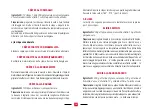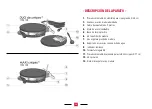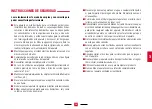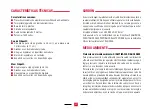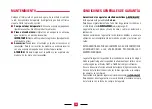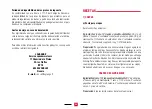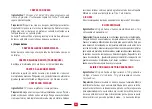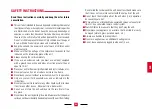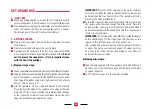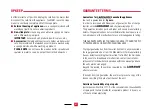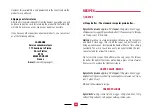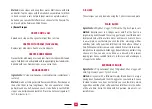
46
SET-UP AND USE
...............................................................................
1 – FIRST USE
■
■
When unpacking appliance, ensure that all materials used to
secure the appliance in transit (wedges, etc.) are carefully removed.
■
■
New appliances may give off a small amount of smoke when first
used. To minimise this, heat up your appliance for 10 minutes
(thermostat level 1) then let it cool down completely.
2- GETTING STARTED
■
■
Plug in your crepe-maker. Set thermostat to maximum. Pre-heat
for 8 minutes.
■
■
Fill accessory stand with water and set it in place.
■
■
Lightly grease the cook plate. To do this, use a small, soft-bristled
brush or a piece of kitchen paper lightly moistened with oil.
Do not
omit to grease the cook plate – it is very important (even
with the non-stick coating).
a) Making a large crepe:
■
■
Take a soup ladle full of batter and pour it onto the middle of the plate.
■
■
Take the batter spreader, holding the handle lightly between thumb
and first two fingers – do not grip it too tightly. Place it on the batter
then spread the batter, using a turning movement (do not press
down). There’s a knack to it!
■
■
Use the spatula to ‘lift’ the crepe and prevent it from sticking.
Place the bevelled edge of the spatula on the edge of the cook
plate and ‘lift’ the crepe by running the spatula around the edge
of the crepe with a circular movement. Always start at the outer
edge and gradually work towards the centre.
IMPORTANT:
Rinse the batter spreader in the water container
after each use. Wipe the spatula carefully in order to remove any
batter particles that may have stuck to it. The spatula can then be
placed on the stand provided for it.
■
■
To turn the crepe over, take a table napkin and fold it in four. Slide
the spatula under the crepe. Go right up to the centre. Place the
napkin over the crepe in such a way that the crepe is sandwiched
between the spatula and the napkin. Then turn the crepe over and
return it to the cook plate.
IMPORTANT:
The first side of the crepe MUST be cooked thoroughly
before attempting to ‘lift’ the crepe. Then, fold the crepe as you
require: in two, into four, into a roll, into a pocket, etc.
N.B.: cooking time varies as a function of temperature and thickness
of crepe. As a guide, you can make at least 20 crepes per hour.
This rises to 35 crepes per hour, depending on consistency of
batter and thickness of crepe.
b) Making mini-crepes:
■
■
Take the ladle supplied with the appliance. Fill it with batter and
pour into one of the indented shapes. Use the back of the ladle
to spread the batter.
■
■
To ‘lift’ and turn crepes, use the spatulas provided.



